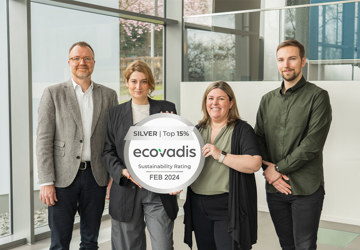

Henkel and Fortify recently initiated a development agreement which allows both companies to mutually combine their areas of expertise and further drive the potential of additive manufacturing. Henkel has developed custom technology that enables durable, high temperature and high modulus resins. Through collaboration, Henkel has designed several formulations that allow Fortify to achieve new outcomes for industrial customers.
“This is a benchmark for the types of collaborations Henkel strives to cultivate. Our strong, data driven approach to material innovation continues to unlock the power of additive manufacturing. Fortify is focused on delivering value in industries where part performance is mission critical. Together we’re making it happen,” says Ken Kisner, innovation lead for 3D printing at Henkel and founder of Molecule Corp which was acquired by Henkel earlier this year.
The combined solution leverages Fortify’s Digital Composite Manufacturing (DCM) 3D printing technology, which mixes reinforcing fibres with Henkel’s resins, and then utilises magnetics to align the fibres for optimum strength in printed parts.
“The Fortify platform enables our customers to leverage materials that weren’t conceivable, yet alone practical on other platforms. With Henkel’s assistance, we are pushing this technology forward and solving the customer problems we expected as well as discovering exciting new opportunities,” says Joshua Martin, CEO and co-founder at Fortify.
With industrial applications, the use of fibre-reinforced polymers continues to accelerate. Injection moulded parts that are reinforced with fibres typically show 20% to 100% increases in strength, stiffness and heat deflection temperature (HDT.) Fortify brings these same performance advantages to the 3D printing space in a variety of use cases.
Injection mould tools as one major focus area
3D printed injection mould tools are one application where Fortify is focusing in its partnership with Henkel. By replacing traditional metal tooling with inserts that are 3D printed, moulders can cut weeks or months out of their schedules while saving a significant amount of costs. While this application has been pursued by others, the step change in performance from reinforced material is the key to success in demanding applications.
“When prototyping or producing parts in small runs, tooling cost and time are major barriers,” says Karlos Delos Reyes, vice-president of applications and co-founder at Fortify. “With our 3D printed moulds that utilise Henkel’s resin, we have proved the viability of these tools for low production runs. As we help injection moulders reduce the expense and time involved with producing moulds, they can quickly react to new opportunities.”
Leveraging Henkel’s material, Fortify will begin field beta testing its 3D printers in the spring of 2020. Beyond injection moulding, Henkel and Fortify are looking at several end use part applications where their combined solutions offer a significant advantage.
“We’re excited about the benefits Fortify’s technology can offer our industrial customers,” adds Ken Kisner. “As new applications are unearthed, our development team is working quickly to help qualify and validate them. We have a wide range of materials in our portfolio and we’re committed to leveraging our knowledge and technology, in partnership with customers and companies like Fortify, to accelerate the growth of additive manufacturing.”

Having spent a decade in the fastener industry experiencing every facet – from steel mills, fastener manufacturers, wholesalers, distributors, as well as machinery builders and plating + coating companies, Claire has developed an in-depth knowledge of all things fasteners.
Alongside visiting numerous companies, exhibitions and conferences around the world, Claire has also interviewed high profile figures – focusing on key topics impacting the sector and making sure readers stay up to date with the latest developments within the industry.





